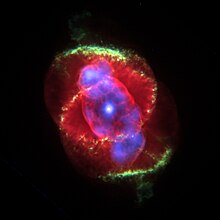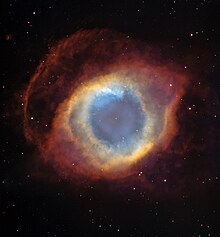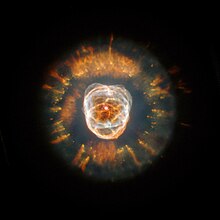Planetary nebula
The first usage may have occurred during the 1780s with the English astronomer William Herschel who described these nebulae as resembling planets; however, as early as January 1779, the French astronomer Antoine Darquier de Pellepoix described in his observations of the Ring Nebula, "very dim but perfectly outlined; it is as large as Jupiter and resembles a fading planet".
[8] They are relatively short-lived phenomena, lasting perhaps a few tens of millennia, compared to considerably longer phases of stellar evolution.
[9] Once all of the red giant's atmosphere has been dissipated, energetic ultraviolet radiation from the exposed hot luminous core, called a planetary nebula nucleus (P.N.N.
[4] Absorbed ultraviolet light then energizes the shell of nebulous gas around the central star, causing it to appear as a brightly coloured planetary nebula.
Starting from the 1990s, Hubble Space Telescope images revealed that many planetary nebulae have extremely complex and varied morphologies.
The mechanisms that produce such a wide variety of shapes and features are not yet well understood, but binary central stars, stellar winds and magnetic fields may play a role.
[10] To early observers with low-resolution telescopes, M27 and subsequently discovered planetary nebulae resembled the giant planets like Uranus.
In 1785, Herschel wrote to Jérôme Lalande: These are celestial bodies of which as yet we have no clear idea and which are perhaps of a type quite different from those that we are familiar with in the heavens.
This led to the idea that planetary nebulae were caused by a star's outer layers being thrown into space at the end of its life.
[23] Infrared and ultraviolet studies of planetary nebulae allowed much more accurate determinations of nebular temperatures, densities and elemental abundances.
[24][25] Charge-coupled device technology allowed much fainter spectral lines to be measured accurately than had previously been possible.
[26][27] Under the Morgan-Keenan spectral classification scheme, planetary nebulae are classified as Type-P, although this notation is seldom used in practice.
[29] Progenitor stars that form planetary nebulae will spend most of their lifetimes converting their hydrogen into helium in the star's core by nuclear fusion at about 15 million K. This generates energy in the core, which creates outward pressure that balances the crushing inward pressures of gravity.
[30] This state of equilibrium is known as the main sequence, which can last for tens of millions to billions of years, depending on the mass.
[32] For the more massive asymptotic giant branch stars that form planetary nebulae, whose progenitors exceed about 0.6M⊙, their cores will continue to contract.
When temperatures reach about 100 million K, the available helium nuclei fuse into carbon and oxygen, so that the star again resumes radiating energy, temporarily stopping the core's contraction.
[21] In the second phase, it radiates away its energy and fusion reactions cease, as the central star is not heavy enough to generate the core temperatures required for carbon and oxygen to fuse.
The star becomes a white dwarf, and the expanding gas cloud becomes invisible to us, ending the planetary nebula phase of evolution.
[37] Planetary nebulae usually contain larger proportions of elements such as carbon, nitrogen and oxygen, and these are recycled into the interstellar medium via these powerful winds.
Although these metals are present in stars in relatively tiny amounts, they have marked effects on stellar evolution and fusion reactions.
A typical planetary nebula is roughly one light year across, and consists of extremely rarefied gas, with a density generally from 100 to 10,000 particles per cm3.
In the latter case, there are not enough UV photons being emitted by the central star to ionize all the surrounding gas, and an ionization front propagates outward into the circumstellar envelope of neutral atoms.
Although there are a few hundred known open clusters within that age range, a variety of reasons limit the chances of finding a planetary nebula within.
[48] For one reason, the planetary nebula phase for more massive stars is on the order of millennia, which is a blink of the eye in astronomic terms.
Also, partly because of their small total mass, open clusters have relatively poor gravitational cohesion and tend to disperse after a relatively short time, typically from 100 to 600 million years.
[51] However, some astronomers postulate that close binary central stars might be responsible for the more complex and extreme planetary nebulae.
[70] Several have been shown to exhibit strong magnetic fields,[71] and their interactions with ionized gas could explain some planetary nebulae shapes.
The discrepancies may be too large to be caused by temperature effects, and some hypothesize the existence of cold knots containing very little hydrogen to explain the observations.











